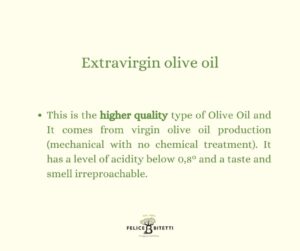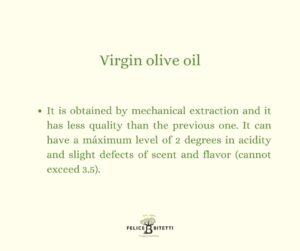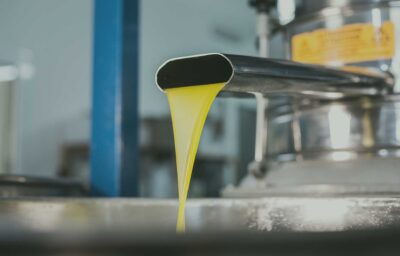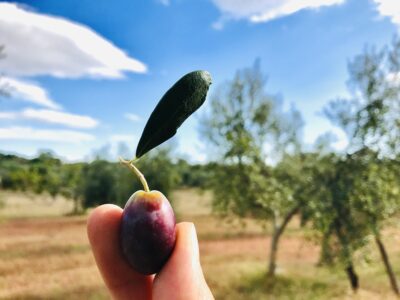To evaluate the quality of the oil and place it in the correct product category, there are various parameters provided for by the EEC legislation in force, including acidity and the number of peroxides K270 and K232. The level of quality is likewise far from other factors including phenolic compounds, fatty acid composition, tocopherols, vitamins etc. In this regard, the European Community classifies olive oil on the basis of three elements: the type of extraction with which the oil was obtained, its composition, including the percentage of free acidity (a parameter measured by analysis chemistry) and organoleptic analysis. By definition: virgin olive oils are oils excluded from the fruit of the olive tree, in conditions that do not cause alteration of the oil, and that have no undergone other than washing, decanting, centrifugation and filtration, treatment of the oils to obtain solvent through action to or with adjuvants action to chemistry or biochemistry or with processes of remixing and any mixture with Perification the quality of the oil and place it in the correct product category there are several parameters provided for by the EEC legislation in force number of peroxides K270 and K232. The quality level is likewise influenced by other factors including phenolic compounds, fatty acid composition, tocopherols, vitamins, etc. In this regard, the European Community classifies olive oil on the basis of three elements: the type of extraction with which the oil was obtained, its composition, including the percentage of free acidity (a parameter measured by analysis chemistry) and organoleptic analysis. By definition: virgin olive oils are oils obtained from the fruit of the olive tree, in conditions that do not cause alteration of the oil, and that have not undergone any treatment other than washing, decanting, centrifugation and filtration, excluding oils obtained by solvent or with adjuvants with chemical or biochemical action or with reesterification processes and any mixture with oils of other nature.
The recognized quality of extra virgin olive oils is therefore the result of two different types of investigation: on the one hand we use chemical-physical analyzes, aimed at ascertaining the real composition in percentage terms of the fat and its degree of acidity; on the other hand we resort to the organoleptic examination, which “measures” the oil from the point of view of its visual, olfactory and taste characteristics and evaluates its strengths and weaknesses.
We can therefore make a first real distinction between superior quality virgin olive oils: extra virgin olive oil is obtained by pressing the olives solely by mechanical means, without the use of solvents or chemicals that can in any way alter their final product. It is also necessary that the oil is cold extracted with temperatures that do not exceed 27 degrees. To be classified as such, extra virgin olive oil must respect some chemical and organoleptic characteristics that we will now explain in the infographic below.













